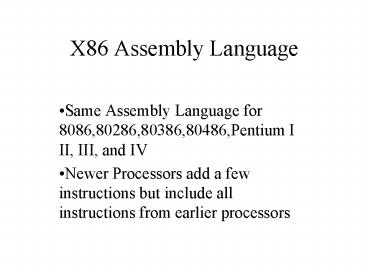X86 Assembly Language - PowerPoint PPT Presentation
1 / 10
Title:
X86 Assembly Language
Description:
CISC machines have more addressing modes one operand can ... X86 Processor Info. Intel's Home Page. http://www.intel.com. AMD's Home Page. http://www.amd.com ... – PowerPoint PPT presentation
Number of Views:247
Avg rating:3.0/5.0
Title: X86 Assembly Language
1
X86 Assembly Language
- Same Assembly Language for 8086,80286,80386,80486,
Pentium I II, III, and IV - Newer Processors add a few instructions but
include all instructions from earlier processors
2
CISC (X86) vs. RISC (MIPS,ARM)
- CISC machines have fewer registers
- CISC machines have more addressing modes one
operand can be memory (no LW or SW) - CISC machines have more instruction formats and
they vary in length - CISC machines have more instructions
- Programs require fewer CISC instructions than
RISC but time/instruction is longer - With pipelining and dynamic execution, a CISC
instruction set is perhaps 10-20 slower than RISC
3
- 1978 The Intel 8086 is announced (16 bit
architecture) - 1980 The 8087 floating point coprocessor is
added - 1982 The 80286 increases address space to 24
bits, instructions - 1985 The 80386 extends to 32 bits, virtual
memory new addressing modes - 1989-1995 The 80486, Pentium, Pentium Pro add a
few instructions (mostly designed for higher
performance) - 1997 57 new MMX instructions are added,
Pentium II - 1999 The Pentium III added another 70
instructions (SSE) - 2001 Another 144 instructions (SSE2)
- 2003 AMD extends the architecture to increase
address space to 64 bits, widens all registers
to 64 bits and other changes (AMD64) - 2004 Intel capitulates and embraces AMD64
(calls it EM64T) and adds more media extensions
4
- Complexity
- Instructions from 1 to 17 bytes long
- one operand must act as both a source and
destination - one operand can come from memory
- complex addressing modes e.g., base or scaled
index with 8 or 32 bit displacement - Saving grace
- the most frequently used instructions are not too
difficult to build - compilers avoid the portions of the architecture
that are slow
5
IA-32 Registers and Data Addressing
- Registers in the 32-bit subset that originated
with 80386
6
IA-32 Register Restrictions
- Registers are not general purpose note the
restrictions below
7
IA-32 Typical Instructions
- Four major types of integer instructions
- Data movement including move, push, pop
- Arithmetic and logical (destination register or
memory) - Control flow (use of condition codes / flags )
- String instructions, including string move and
string compare
8
IA-32 instruction Formats
- Typical formats (notice the different lengths)
9
X86 Assembly Resources (Free)
- Free AMD X86 manuals
- http//www.intel.com/design/pentiumii/manuals/2431
9102.PDF
10
X86 Processor Info
- Intels Home Page
- http//www.intel.com
- AMDs Home Page
- http//www.amd.com

